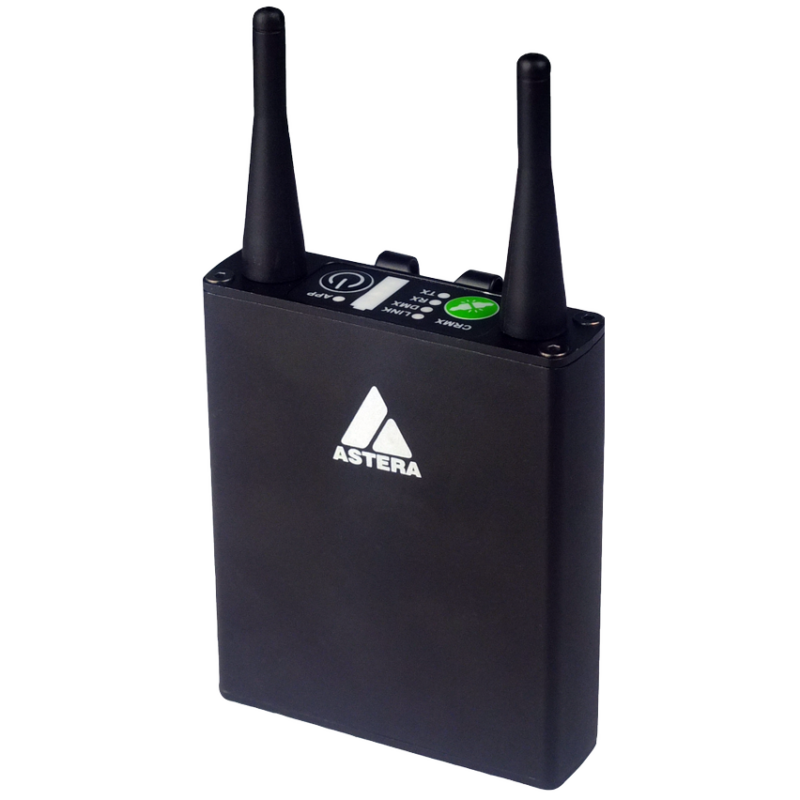Order Code | ART7-U |
|---|---|
DC Input | 5 VDC – 2 A |
Battery Voltage | 3.7 V |
Battery Runtime | 72 h (App) 8-10 h (CRMX) |
Charging Time (nominal) | 8 hours |
Ports | Micro-USB for charging, 3.5 mm jack for DMX Input |
DC Connector | Micro-USB |
BluetoothBridge BTB | Built-in |
Bluetooth Classic | Yes |
Wireless Protocols | UHF, CRMX, Bluetooth 4.0 |
Wireless Range | CRMX: up to 300 m / 328 yds UHF: up to 300 m / 328 yds Bluetooth: up to 3 m / 3.3 yds |
Microphone | Built-in |
Housing Material | Aluminium |
IP Rating | IP20 |
Ambient Operating Temperature | 0 – 40 °C / 32 – 104 °F |
Weight | 0.23 kg / 0.51 lbs |
Dimensions L x W x D | 146 mm x 78 mm x 30 mm / 5.7" x 3.1" x 1.2" |
Mounting Options | Belt Clip |

Technical Specifications
What's in the Box
- 1x AsteraBox (ART7)
- 1x DMX Adapter (ART7-DMXA)
- 1x Power Supply (ART7-CHR-U)
- 1x Carry Case (ART7-CSE)
RF Characteristics
For AsteraBox
Wireless Modules | Modulation | ERP (Transmitter) | Channel Count |
|---|---|---|---|
EU: UHF (863-870MHz) | FHSS | <25mW | 47 |
USA: UHF (917-922.20MHz) | FHSS | <25mW | 53 |
AUS: UHF (922.30-927.50MHz) | FHSS | <25mW | 53 |
SGP: UHF (920.50-924.50MHz) | FHSS | <25mW | 41 |
KOR: UHF (917.9-921.5MHz) | FHSS | <25mW | 10 |
RUS: UHF (868.75-869.12MHz) | FHSS | <25mW | 6 |
JPN: UHF (922.80-926.40MHz) | FHSS | <25mW | 19 |
CRMX (2402-2480MHz) | FHSS | <100mW | 79 |
Bluetooth 4.1 (2402-2480MHz) | FHSS | 2mW (classic) | 79 |
Bluetooth 4.1 (2402-2480MHz) | FHSS | 2mW (BLE) | 40 |
***General allocation of frequencies for use by short-range radio applications Spectrum usage regulations:
Frequency range in MHz1) | Maximum equivalent radiant power (ERP) | Additional parameters / frequency access and interference mitigation techniques |
|---|---|---|
865 – 868 | 25 mW | Requirements for frequency access and mitigation techniques3) Alternatively, a maximum duty cycle2) of 1% can be used. |
868,0 – 868,6 | 25 mW | Requirements for frequency access and mitigation techniques3) Alternatively, a maximum duty cycle2) of 1% can be used. |
868,7 – 869,2 | 25 mW | Requirements for frequency access and mitigation techniques3) Alternatively, a maximum duty cycle2) of 0.1% can be used. |
869,40 – 869,65 | 500 mW | Requirements for frequency access and mitigation techniques3) Alternatively, a maximum duty cycle2) of 10% can be used. |
869,7 – 870,0 | 25 mW | Requirements for frequency access and mitigation techniques3) Alternatively, a maximum duty cycle2) of 1% can be used. |
1) The use of adjacent frequency bands within this table as a single frequency band is permitted, provided that the specific conditions for each of these adjacent frequency bands are met. 2) „duty cycle“ means the ratio of Σ(Ton)/(Tobs) expressed as a percentage, where ‚Ton‘ is the ‚on-time‘ of a single transmitting device and ‚Tobs‘ is the observation period Ton is measured in an observation frequency band (Fobs). Unless otherwise specified in this general allocation, Tobs is a continuous period of one hour and Fobs is the applicable frequency band in this general allocation (table). 3) Frequency access and interference mitigation techniques shall be used whose performance level at least meets the essential requirements of Directive 2014/53/EU or the Radio Equipment Act (FuAG). Where relevant techniques are described in harmonised standards, the references of which have been published in the Official Journal of the European Union pursuant to Directive 2014/53/EU, or parts thereof, performance shall be ensured which is at least equivalent to those techniques.